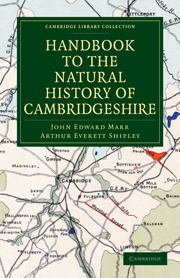Book contents
- Frontmatter
- PREFACE
- Contents
- ADDENDA AND CORRIGENDA
- PHYSIOGRAPHY
- GEOLOGY
- VERTEBRATE PALÆONTOLOGY
- ZOOLOGY
- Mammals
- Birds
- Reptiles and Amphibians
- Fishes
- Mollusca
- Insects: Introduction
- Insects: Orthoptera
- Insects: Neuroptera
- Insects: Hemiptera
- Insects: Coleoptera
- Insects: Lepidoptera
- Insects: Diptera
- Insects: Hymenoptera
- Myriapoda
- Arachnida
- Crustacea
- FLORA
- PREHISTORIC ARCHÆOLOGY
- Appendix to the Article on the Mollusca
- INDEX
- Plate section
Reptiles and Amphibians
Published online by Cambridge University Press: 10 November 2010
- Frontmatter
- PREFACE
- Contents
- ADDENDA AND CORRIGENDA
- PHYSIOGRAPHY
- GEOLOGY
- VERTEBRATE PALÆONTOLOGY
- ZOOLOGY
- Mammals
- Birds
- Reptiles and Amphibians
- Fishes
- Mollusca
- Insects: Introduction
- Insects: Orthoptera
- Insects: Neuroptera
- Insects: Hemiptera
- Insects: Coleoptera
- Insects: Lepidoptera
- Insects: Diptera
- Insects: Hymenoptera
- Myriapoda
- Arachnida
- Crustacea
- FLORA
- PREHISTORIC ARCHÆOLOGY
- Appendix to the Article on the Mollusca
- INDEX
- Plate section
Summary
Of the thirteen different species of Amphibia and Reptiles of England eleven are known to occur, and to breed, in Cambridgeshire. In the following pages no notice is taken of specimens which have obviously escaped from captivity. For instance, Prof. Henslow in 1824 met with a Natterjack in the Old Botanic Garden, the present Museum-grounds. In the present Botanic Garden now and then a continental frog has been found, and at the Leys School opposite boys occasionally bring such a frog from London and keep it for a while. A spotted or Fire Salamander has crawled across Chesterton Road after a thunderstorm, and inquiry into its ownership was of no avail. I mention this case because a gentleman, who knows this species from continental experience, has assured me that he has met several of them at a certain place on the East Coast.
REPTILIA
Of the three British species the only snake of Cambridge and its neighbourhood for many miles around is the Common or Grass-snake, Tropidonotus natrix. It is easily recognisable by the pair of light-coloured, yellow or white, patches on the neck, immediately behind the head; this light collar is always present in the snakes of this county. The Grass-snake prefers moist, grassy localities, with the neighbourhood of water, chiefly on account of the food, which consists entirely of fishes and amphibians, notably of frogs; toads are occasionally eaten, but mice are never taken, although a Radiograph was once exhibited at a learned Society's Meeting showing a Grass-snake in the act of swallowing a mouse, but horribile dictu, the mouse had been shoved by force into the unwilling snake's mouth! The Grass-snake never bites, although hissing and striking out furiously with its head.
- Type
- Chapter
- Information
- Handbook to the Natural History of Cambridgeshire , pp. 100 - 107Publisher: Cambridge University PressPrint publication year: 2010First published in: 1904

